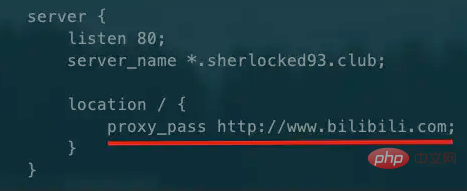

Reverse proxy is the most commonly used server function in work and is often used to solve cross-domain problems. Let’s briefly introduce how to implement reverse proxy.
First enter the main configuration file of Nginx:
vim /etc/nginx/nginx.conf
(Recommended tutorial:nginx usage tutorial)
Then we go to the server block of the http module location/, add a line to redirect the default URL to the proxy_pass configuration of the largest learning website Bilibili:

Save and exit after changing,nginx -s reloadReload, enter the default URL, and now jump directly to station B, implementing a simple proxy.
In actual use, the request can be forwarded to another server on this machine, or it can be jumped to a service on a different port based on the access path.
For example, we listen to port 9001, and then perform reverse proxy for requests to access different paths:
Forward requests to access http://127.0.0.1:9001/edu to http:/ /127.0.0.1:8080
Forward the request to access http://127.0.0.1:9001/vod to http://127.0.0.1:8081
How to configure this , first open the main configuration file, and then add a server block under the http module:
server { listen 9001; server_name *.sherlocked93.club; location ~ /edu/ { proxy_pass http://127.0.0.1:8080; } location ~ /vod/ { proxy_pass http://127.0.0.1:8081; } }
There are some other instructions for reverse proxy, you can learn about it:
1. proxy_set_header: in Change the request header information from the client before sending it to the backend server.
2. proxy_connect_timeout: Configure the timeout period for Nginx to try to establish a connection with the backend proxy server.
3. proxy_read_timeout: Configure Nginx to wait for the corresponding timeout after issuing a read request to the backend server group.
4. proxy_send_timeout: Configure Nginx to wait for the corresponding timeout after sending a write request to the backend server group.
5. proxy_redirect: used to modify the Location and Refresh in the response header returned by the back-end server.
The above is the detailed content of How to configure nginx reverse proxy. For more information, please follow other related articles on the PHP Chinese website!
 nginx restart
nginx restart Detailed explanation of nginx configuration
Detailed explanation of nginx configuration Detailed explanation of nginx configuration
Detailed explanation of nginx configuration What are the differences between tomcat and nginx
What are the differences between tomcat and nginx Solution to insufficient cloud storage space
Solution to insufficient cloud storage space Self-study for beginners in C language with zero foundation
Self-study for beginners in C language with zero foundation How to open a 404 website
How to open a 404 website Detailed explanation of Symbol class in JS
Detailed explanation of Symbol class in JS